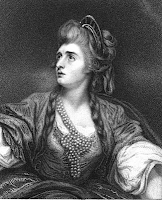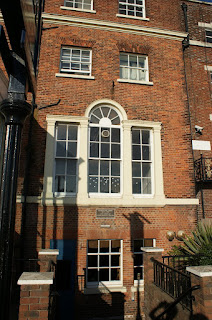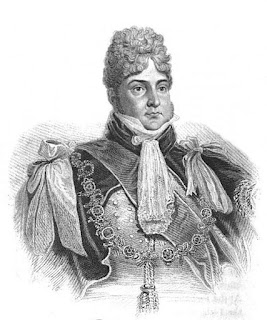 |
| Princess Mary from A Biographical Memoir of Frederick, Duke of York and Albany by J Watkins (1827) |
Princess Mary (25 April 1776-30 April 1857) was the 11th child and 4th daughter of King George III and Queen Charlotte. She married her cousin William, Duke of Gloucester, and was the only one of her siblings to be photographed.
Birth of the fourth Princess
Mary was born on 25 April 1776 at Buckingham House, and was christened on 19 May in the great council chamber at St James’ Palace by the Archbishop of Canterbury.
Education
The Princesses were educated at home by governesses and teachers under the direction of Lady Charlotte Finch. It was the Queen, however, who ultimately had control. Together with the King, she chose all the tutors and sub-governesses, attended her daughters’ schoolroom whenever her other duties allowed and arranged the timetable of governesses to ensure that her children were always supervised. The Princesses were taught English, French, German, geography, history, music, art and needlework. Mary was very musical and became skilled at copying drawings in chalk.
Entertaining diversions
Life in the royal household followed a strict routine and the Princesses were allowed very little freedom. Occasionally, the tedium was interrupted by a trip or entertainment. On 17 May 1787, The Way to Keep Him, a comedy, was privately performed for the King and Queen; the Princesses Charlotte, Augusta, Elizabeth, Mary and Sophia were all present.
The Princesses also attended the grand festival at Westminster on 28 May, featuring music by Handel, and a further comedy, The Jealous Wife, was performed for them at Buckingham House on 30 May by Mrs Siddons and Mr Kemble. At other times, they visited the theatre or an exhibition, but there was little scope for independent amusement.
 | |
| Mrs Siddons from La Belle Assemblée (1812) |
On 2 June 1788, the Spanish ambassador held a magnificent gala at Ranelagh which Mary and her elder sisters attended. The amusements included a lottery of watches and jewellery, moving transparencies, Spanish children dancing and fireworks, as well as country dancing in which Mary took part.
Mary attended Court for the first time in June 1791 to celebrate the King’s birthday; her cousin, Prince William of Gloucester, also made his first appearance. Mary danced a minuet with her brother William, Duke of Clarence.
Weymouth
In 1789, and in most subsequent summers until 1805, Mary visited Weymouth with her family. The Princesses went bathing in the sea and rode a donkey chaise around the Shrubbery. Sometimes they attended a public breakfast given by some local dignitary or went out in the carriage to a country estate. In the evening they played cards or went to the theatre where the King was invariably amused by a repetition of the same plays.
 |
| Weymouth, Dorset |
Mary visited Weymouth again in 1808 when she accompanied Princess Amelia there as she battled against tuberculosis. Mary was her sister’s devoted nurse and constant companion and Amelia referred to her as “Dearest Minny”.
After her marriage, she visited Weymouth with her husband, the Duke of Gloucester, and it was while staying at Gloucester Lodge in 1817 that she heard the devastating news of Princess Charlotte’s death in childbirth.
 |
| Gloucester Lodge, Weymouth, as it is today today |
Mary was kind and affectionate and was the Prince of Wales’ favourite sister. On her death, Prince Albert described her as “a lady whose virtues and qualities of the heart had commanded the respect and love of all who knew her”.
 |
| The Prince of Wales, later George IV from Memoirs of her late royal highness Charlotte Augusta by Robert Huish (1818) |
Marriage
On 22 July 1816, Mary married her cousin, William Frederick, Duke of Gloucester. The couple lived at Bagshot Park, in Surrey, about eleven miles from Windsor, and Gloucester House, Park Lane, in London. William and Mary had no children.
 |
| William Frederick, Duke of Gloucester from A Biographical Memoir of Frederick, Duke of York and Albany by John Watkins (1827) |
Final years
After the Duke’s death in 1834, Mary lived a retired life, but her kindness and benevolence endeared her to all. She was the last surviving child of George III and the only one of her generation to be photographed.
She died on 30 April 1857 at Gloucester House in London at the age of 81 and was taken by the Great Western Railway from Paddington to Windsor, where she was buried beside her husband in St George’s Chapel, Windsor Castle, on 9 May.
Queen Victoria wrote of her: “Her age, and her being a link with bygone times and generations…rendered her more and more dear and precious to us all, and we all looked upon her as a sort of grandmother.”
Sources used include:
Bell, John, La Belle Assemblée, various (1806-1831, London)
Chedzoy, Alan, Seaside Sovereign - King George III at Weymouth, (Dovecote Press, 2003, Dorset)
Hall, Mrs Matthew, The Royal Princesses of England (1871, London)
Hibbert, Christopher, George IV (Longmans,1972, Allen Lane, 1973, London)
Oulton, Walley Chamberlain, Authentic and Impartial Memoirs of Her Late Majesty Charlotte, Queen of Great Britain and Ireland (1819, London)
Papendiek, Mrs, Court and private life in the time of Queen Charlotte: being the journals of Mrs Papendiek assistant keeper of the wardrobe and reader to her Majesty, edited by her granddaughter, Mrs Vernon Delves Broughton (1887, London)
Purdue, AW, George III, daughters of (act.1766-1857), Oxford Dictionary of National Biography, (Oxford University Press, 2004, online edn, May 2009, accessed 10 Feb 2012)
Watkins, John, A Biographical Memoir of Frederick, Duke of York and Albany (1827, London)
All photographs © Andrew Knowles - www.flickr.com/photos/dragontomato

No comments:
Post a Comment